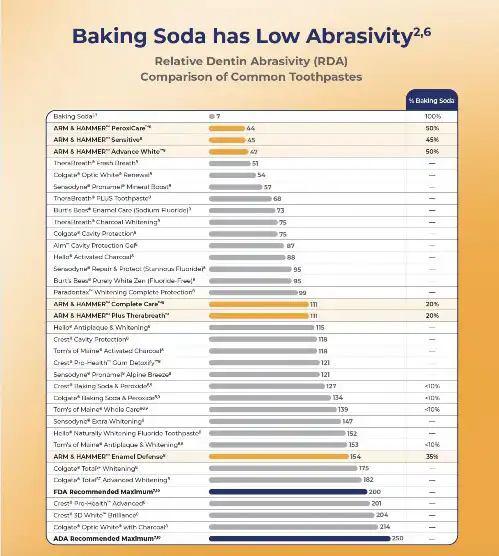Why Baking Soda Toothpastes Have a Low RDA and High Plaque Removal
Toothpaste abrasives have to achieve a difficult balance. They have to be abrasive enough to remove plaque, but still gentle enough that they don't harm enamel or exposed dentin. Healthy enamel may be significantly resistant to abrasion, but many adults don't have healthy teeth. The result? The relative dentin abrasivity (RDA) of a toothpaste is important to consider for every patient.
Firstly, there are some alarming statistics regarding dental health. Approximately 50% of adults, aged 30+ have signs of gum disease1, and we know that 82% of adults under 35 have had one or more cavities2. Being that dentin is up to ten times softer than enamel, we want to protect that dentin as much as possible, and do everything we can to avoid damaging it. Dietary acids can soften both enamel and dentin, making them less resistant to abrasive wear. Risk can also be higher in patients who have periodontal diseases, tooth sensitivity, and conditions affecting saliva flow, like autoimmune conditions, diabetes, pregnancy, and cancer. Therefore, a toothpaste's abrasivity can make a difference in a patient's oral health.
Toothpaste abrasives are an important factor in the overall RDA value of toothpaste. Abrasives are important to remove and disrupt plaque, but not all abrasives are created equal. Common toothpaste abrasives include hydrated silica, calcium pyrophosphate, dicalcium phosphate, and sodium bicarbonate - also known as baking soda. Of these four, baking soda is the most gentle with an RDA level of 7, while still being excellent at removing plaque. According to the JADA article, "Baking soda dentifrices and oral health," "the use of a baking soda dentifrice provides a measure of safety to enamel and dentin in spite of the "vigor" patients may use while brushing their teeth3." Considering the risks of over-brushing, this is no small benefit.
For context, the FDA recommends a maximum RDA of 200, and the ADA a maximum of 2504. This makes toothpastes made with baking soda some of the gentlest on the market, which is especially true for toothpastes with a higher percentage of baking soda. Arm & Hammer™ Peroxicare™, Sensitive™, and Advance White™ toothpastes have RDA levels of 44, 45, and 47 at 50%, 45%, and 50% baking soda respectively. Meanwhile, Arm & Hammer™ Complete Care™ and Arm & Hammer™ Plus TheraBreath™ contain 20% baking soda for an RDA of 111 - still well within the FDA and ADA recommended maximums, and of benefit to patients who are sensitive to the taste of baking soda, which can be a little salty.
This is especially astonishing for a whitening toothpaste like Advance White™ since toothpastes with a whitening agent can have quite high RDA levels. In fact, the same JADA article states that, "in spite of its low abrasivity, dentifrices containing baking soda are more effective in stain removal and whitening than some non-baking soda- containing dentifrices with a higher abrasivity3." So, your patients can use a baking soda toothpaste to naturally and gently whiten their teeth instead of using more harmful whitening products. You can refer to the chart below to explore the RDA levels of Arm & Hammer baking soda toothpastes among other toothpastes from leading brands.

But perhaps what's most interesting is that baking soda toothpaste can have such a low RDA and still be so effective at removing plaque. The JADA article, "Effect of baking soda in dentifrices on plaque removal," notes that, "hydrated silica, alumina, and calcium pyrophosphate are biologically inert and only impose a mechanical debridement action5." In other words? They're only removing the plaque that the toothbrush touches. Baking soda, meanwhile, "has both mechanical and biological mechanisms of action." A toothpaste that contains baking soda foams up and disperses throughout the whole mouth, helping to remove plaque from those hard to reach areas.
If toothpastes walk a fine line between being abrasive enough to remove plaque, debris, and stains, but gentle enough to not harm your teeth, baking soda manages to achieve both without sacrifices. Baking soda toothpastes prove you can have a toothpaste that is gentle while also being exceptional at removing plaque. Because your patients deserve a healthy mouth, and so do you.

- Eke PI, Dye BA, et al. CDC Study: Prevalence of periodontitis in Adults 2009-2010. J Dent Res Aug. 30, 2012
- Dye BA, Thornton-Evans G, et al. NCHS Data Brief May 2015;197:1-8.
- Ciancio, Sebastian G. "Baking Soda Dentifrices and Oral Health." JADA, 2017, jada.ada.org/article/S0002-8177(17)30822-X/fulltext
- Rath SK, Sharma V, et al. SRM Jnl Res Dent Sci 2016;7:96-100.
- Myneni, Srinivas R. "Effect of Baking Soda in Dentifrices on Plaque Removal - The ..." JADA, 2017, jada.ada.org/article/S0002-8177(17)30809-7/fulltext.